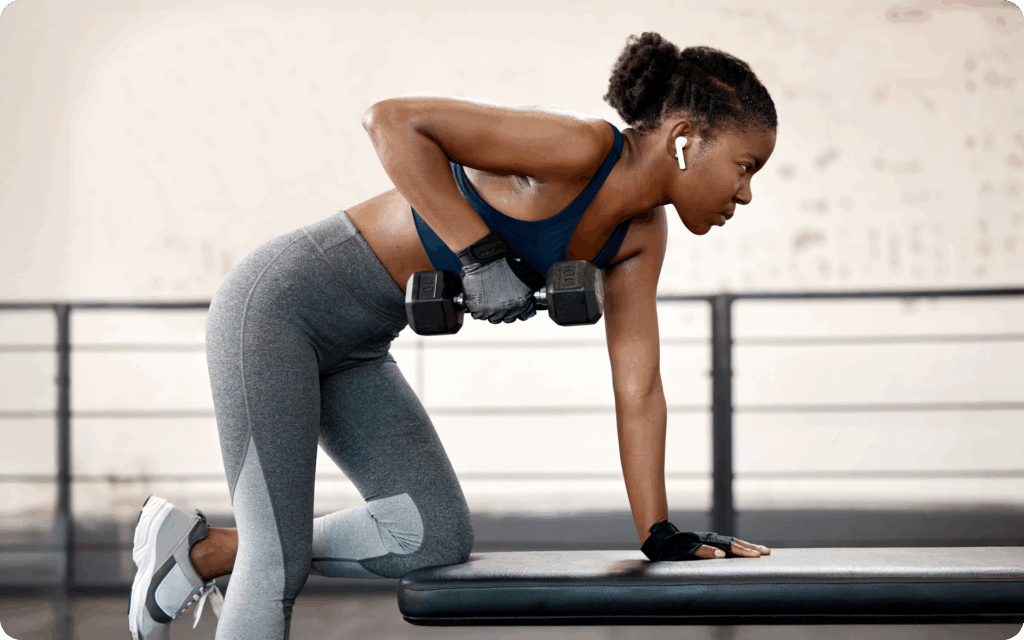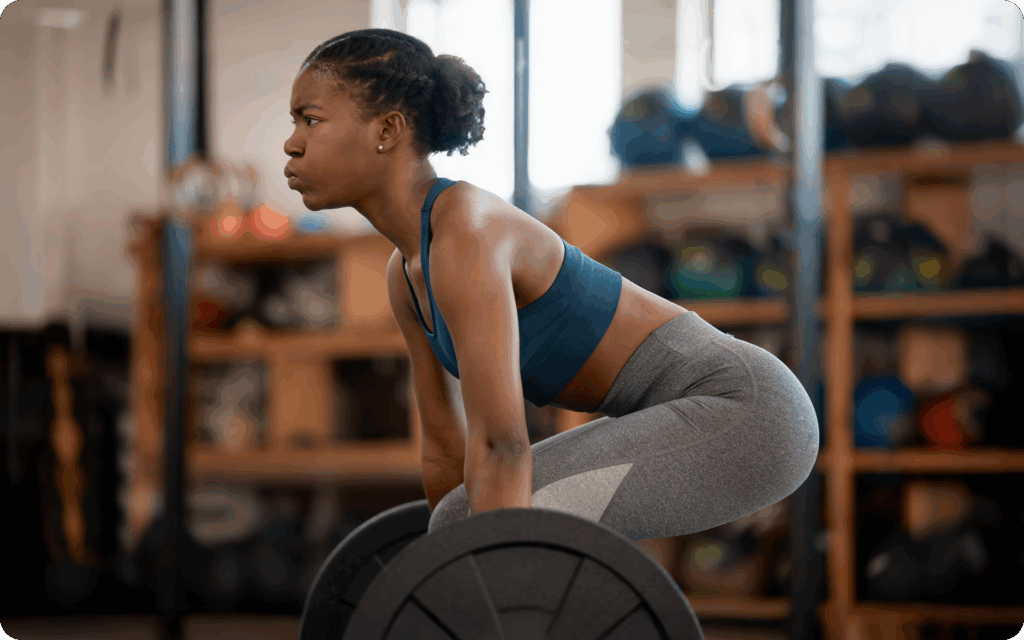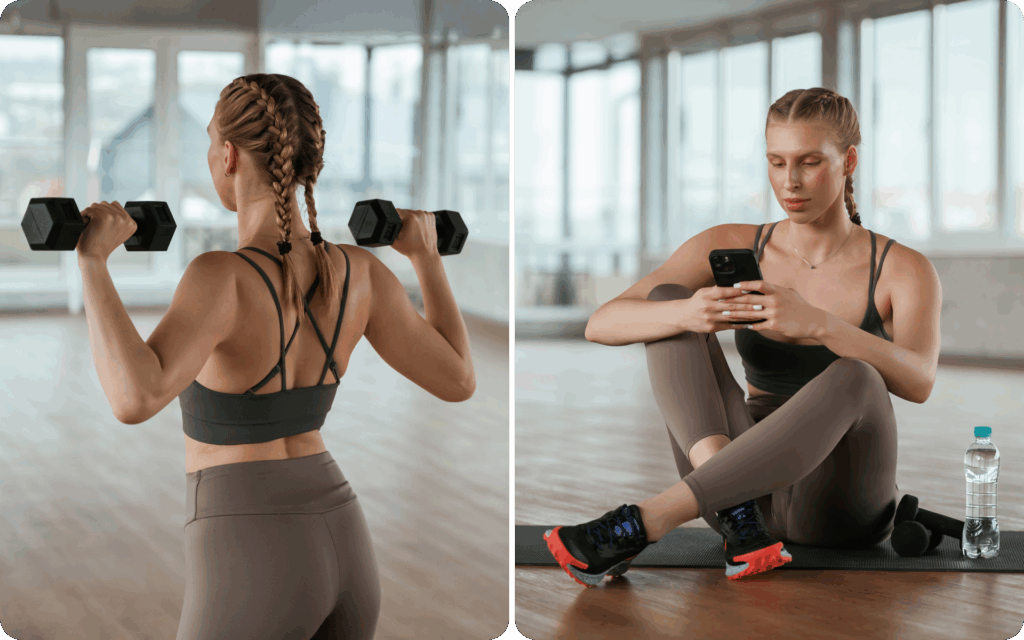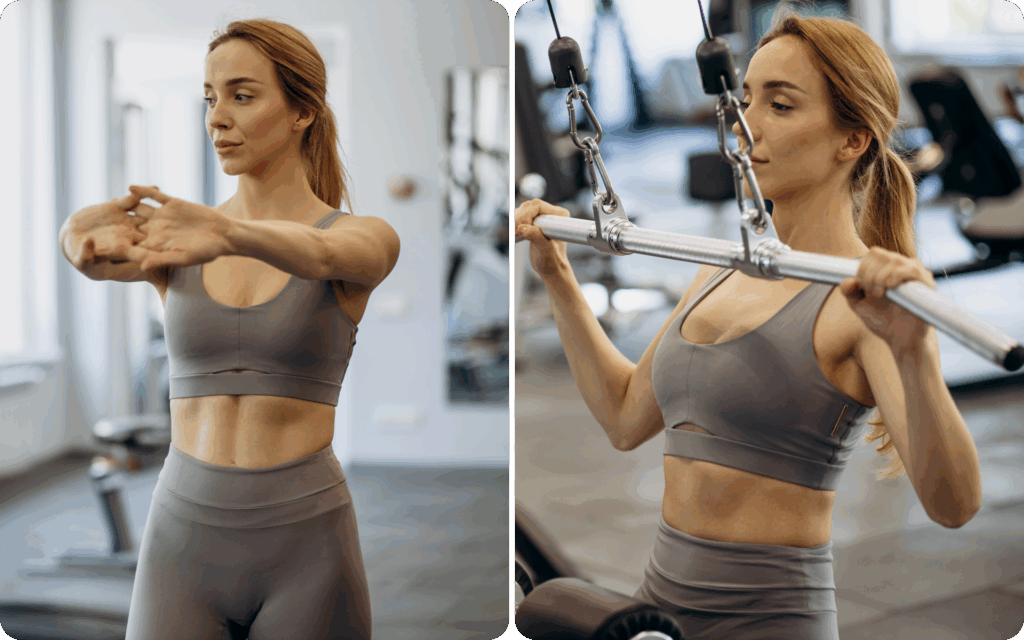Building strength is a science, and with the right blueprint, you can unlock impressive gains in force and power. This guide cuts through the noise, translating complex physiology into a practical, step-by-step strength building workout plan. We’ll move from the fundamental principles of strength adaptation to a complete 12-week program you can start today.
Read on for the latest research, ensuring your efforts in the gym are as efficient and effective as possible. You’ll learn not just what to do, but why it works, empowering you to take control of your training and achieve sustainable results.
How Do I Build Strength Fast?
You can build strength fastest by prioritizing neural adaptations through using heavier loads (≥ 85%1RM), not just building bigger muscles.
Strength is a skill, and your nervous system is the master controller. The quickest gains, particularly in the first 4 to 8 weeks of a new program, come from improving your neuromuscular system. This is when you teach your brain to use the muscle you already have more efficiently.
The Science
Strength is your neuromuscular system’s ability to produce force against external resistance. Recent evidence sharpens our understanding of how this happens.
A critical 2025 review on neuromuscular adaptations highlighted that early strength gains are dominated by neural factors (1). This means your initial progress comes from:
- Improved Motor Unit Recruitment: A motor unit is a single motor neuron and all the muscle fibers it activates. To lift a heavy weight, your brain must recruit more of these units. Training with heavy loads, specifically those at or above 85% of your one-rep max, teaches your central nervous system to turn on more motor units simultaneously (1).
- Increased Firing Rate: Your brain also learns to send signals to your muscles faster and more frequently. This increased firing rate, or rate coding, allows your muscles to contract with greater force (1).
- Enhanced Synchronization: Your motor units learn to fire in a more coordinated, synchronized pattern, creating a powerful, unified contraction instead of a choppy, inefficient one (1).
- Reduced Antagonist Co-activation: When you perform a movement such as a bicep curl (flexion), your triceps (the antagonist muscle) must relax. Untrained individuals often have high co-activation, where antagonist muscles contract and “fight” the primary movement. Strength training reduces this internal resistance, allowing more of your force to be directed toward lifting the weight (1).
The Role of Muscle Architecture and Tendons
While neural changes come first, physical changes to the muscle and connective tissues amplify your strength potential over time.
- Muscle Pennation Angle: This is the angle at which muscle fibers attach to the tendon. Strength training can increase this angle, which allows more muscle fibers to be packed in parallel. A greater pennation angle enables the muscle to generate more force, even without a significant increase in overall muscle volume (2)
- Tendon Stiffness: Heavy lifting places stress on your tendons, which adapt by becoming stiffer. A stiffer tendon transmits force from the muscle to the bone more rapidly and efficiently (3). This adaptation is crucial for improving your rate of force development (RFD) – how quickly you can reach peak force. Better RFD is what makes you feel explosive and powerful (4).
The Key Takeaway: Intensity Is King
In the strength and conditioning world, intensity refers to how heavy a load you use. And to get stronger, you must practice lifting heavy.
While moderate loads of 60-80% of your one-repetition maximum (1RM) – the most weight you can lift for a single rep – are excellent for building muscle size, they don’t optimize the neural adaptations that are required for maximal strength. Spending dedicated time lifting weights at 85% of your 1RM or higher is non-negotiable for teaching your body the skill of being strong (1).
This is why a powerlifter can often lift more than a bodybuilder of the same size, or even bigger. The powerlifter has specifically trained their nervous system to produce maximal force, while the bodybuilder has focused on the stimulus for muscle growth.
Reasons why BetterMe is a safe bet: a wide range of calorie-blasting workouts, finger-licking recipes, 24/7 support, challenges that’ll keep you on your best game, and that just scratches the surface! Start using our app and watch the magic happen.
What Exercises Can Build Strength?
The best exercises to build strength are multi-joint, compound movements that recruit large amounts of muscle mass and allow for progressive overload (5). These are also more effective for improving the neuromuscular system as more muscles must learn to work together.
These are the foundational lifts that have the greatest carryover to overall strength and real-world performance.
You can categorize these essential movements into four primary patterns:
- Squat: A lower-body movement pattern involving coordinated flexion and extension at the hips, knees, and ankles.
- Hinge: A hip-dominant movement where you bend at the waist while maintaining a relatively straight back, primarily training the posterior chain (glutes, hamstrings, lower back).
- Push: An upper-body movement where you push a weight away from your body, either horizontally (such as a push-up) or vertically (such as an overhead press).
- Pull: An upper-body movement where you pull a weight toward your body, also performed horizontally (such as a row) or vertically (such as a pull-up).
Foundational Strength Building Exercises
Here are the primary exercises that should form the core of any serious strength program.
1. The Barbell Back Squat
The undisputed king of lower-body strength. It develops powerful quads, glutes, adductors, and a strong core.
- Execution:
- Set a barbell in a squat rack at about collarbone height. Position your hands on the bar just outside your shoulders and dip under it, resting the bar across your upper back (traps), not your neck.
- Stand up to unrack the weight and take two steps back. Place your feet shoulder-width apart, with your toes pointed slightly outward (around 15-30 degrees).
- Take a deep breath into your belly to brace your core. Initiate the movement by breaking at the hips and knees simultaneously, as if sitting back into a chair.
- Keep your chest up and your gaze forward. Descend until your hip crease is below the top of your knee (below parallel).
- Drive your feet through the floor to ascend, leading with your chest and keeping your hips underneath you. Exhale forcefully as you return to the starting position.
- Cues: Spread the floor with your feet; Keep your chest proud; Drive your upper back into the bar.
2. The Conventional Deadlift
The ultimate test of total-body strength, the deadlift trains your hamstrings, glutes, entire back, core, and grip.
- Execution:
- Stand with your feet hip-width apart, with the middle of your feet directly under the barbell.
- Hinge at your hips and bend your knees to grip the bar just outside your shins. Use a double-overhand or a mixed grip (one palm facing forward, one back).
- Flatten your back, pull your shoulders down and back, and engage your lats. Your hips should be lower than your shoulders.
- Take a deep breath and brace your core. Initiate the lift by driving your feet through the floor, as if you’re pushing the world away.
- As the bar passes your knees, drive your hips forward to meet the bar. Stand up tall, finishing with your glutes squeezed. Don’t lean back.
- Lower the weight with control by reversing the motion: hinge at the hips first, then bend your knees once the bar clears them.
- Cues: Push the floor away; Keep the bar close to your body; Squeeze your glutes at the top.
3. The Bench Press
This is the classic upper-body push exercise for building a strong chest, shoulders, and triceps.
- Execution:
- Lie on a flat bench with your feet firmly planted on the floor. Your eyes should be directly under the barbell.
- Grip the bar with your hands slightly wider than shoulder-width apart. Arch your upper back slightly and retract your shoulder blades, as if trying to pinch them together.
- Unrack the weight and stabilize it directly over your shoulders with your arms locked.
- Take a deep breath and lower the bar in a controlled manner to your mid-chest (around the sternum). Keep your elbows tucked at about a 45-75 degree angle from your body, not flared out to 90 degrees.
- Once the bar touches your chest, drive your feet into the floor and press the bar explosively back up to the starting position.
- Cues: Bend the bar to engage your lats; Drive your feet through the floor; Meet the bar with your chest.
4. The Pull-Up / Chin-Up
This is the gold standard for developing upper-body pulling strength, targeting the lats, biceps, and mid-back.
- Execution:
- Grip a pull-up bar with your hands slightly wider than shoulder-width apart (overhand grip for pull-ups, underhand for chin-ups).
- Start from a dead hang with your arms fully extended. Retract your shoulder blades to engage your back muscles.
- Initiate the pull by driving your elbows down and back. Focus on pulling with your back, not just your arms.
- Continue pulling until your chin clears the bar.
- Lower yourself back down with control to the starting dead-hang position.
- Cues: Pull your elbows to your back pockets; Imagine pulling the bar to your chest; Keep your core tight to prevent swinging.
If you need a more introductory program, you can lay a solid foundation with our full-body strength training routine.
Read more: Lose Fat, Gain Muscle Workout Plan – Exercises and Healthy Eating Tips Included
What Is the Best Workout Routine to Build Strength?
The best workout routine to build strength is one that is structured around the principles of specificity, progressive overload, and fatigue management, using a frequency that allows for high-quality repetitions.
There’s no single “magic” routine, but an optimal framework will prioritize heavy, compound lifts and manipulate key training variables based on scientific evidence.
A 2024 meta-regression on resistance training dose-response relationships found that while muscle growth responds well to increasing weekly volume (total sets), strength gains have a more complex relationship. More volume isn’t always better for strength – intensity and quality are paramount (6).
The Key Programming Variables
Here’s how to structure your training for maximal strength.
- Intensity: As established, intensity is the most critical variable. Spend the majority of your main-lift work in the 1-5 rep range, which corresponds to 85-100% of your 1RM (7).
- Volume: For strength, volume is a tool to support intensity, not the primary driver. A good starting point is 3-6 working sets per main exercise (7). Beyond a certain point, adding more sets can lead to neural fatigue, which degrades technique and force output.
- Frequency: Training a lift or muscle group 2-3 times per week is generally superior to the traditional “bro split” of once per week. Higher frequency allows you to accumulate more high-quality practice with heavy loads without generating excessive fatigue in a single session (8). It’s a key component of a full week workout plan for muscle gain and strength.
- Rest Intervals: For maximal strength, longer rest periods are non-negotiable. A 2024 Bayesian meta-analysis concluded that rest intervals of 2-5 minutes consistently outperform shorter rests (under 90 seconds) for strength gains (9). Longer rests allow for near-complete replenishment of ATP-PC, the immediate energy system used for explosive efforts, which ensures you can give maximal effort on every set.
- Effort: Train close to failure, but not to failure, on your main lifts. Use the rate of perceived exertion (RPE) scale, where RPE 10 is maximal effort with no more reps possible (10). On your heavy sets, aim for an RPE of 8-9, which means you feel you have 1-2 good reps left in the tank. This preserves technique and prevents a dramatic drop-off in bar speed.
For those who prefer bodyweight exercises, many of these principles can be applied to calisthenics strength training.
What Is a Powerful Strength Building Workout Plan?
A powerful strength building workout plan is a periodized program that systematically manipulates training variables over time to drive adaptation while managing recovery. The following 12-week plan is designed for an intermediate lifter and can be adapted for a strength building workout plan for beginners by reducing the initial intensities.
This plan uses a 4-day upper/lower split, allowing each main lift to be trained twice per week – one day focused on heavy intensity and the other on volume and technical practice.
12-Week Periodized Strength Program
Weekly Schedule:
- Monday: Lower-body strength (heavy squat, volume hinge)
- Tuesday: Upper-body strength (heavy bench, volume pull)
- Thursday: Lower-body power (heavy hinge, volume squat)
- Friday: Upper-body power (heavy overhead press, volume bench/pull)
Block 1: Accumulation (Weeks 1-4) – Building a Work Capacity Base
The focus here is on accumulating volume to build muscle and prepare connective tissues for heavier loads.
| Day | Exercise | Sets x Reps | %1RM / RPE | Rest |
|---|---|---|---|---|
| Monday | 1. Barbell back squat | 4 x 5 | 80% / RPE 8 | 3-4 mins |
| 2. Romanian deadlift | 3 x 8 | RPE 7-8 | 2-3 mins | |
| 3. Leg press | 3 x 10 | RPE 8 | 2 mins | |
| 4. Leg curl | 3 x 12 | RPE 9 | 90 secs | |
| 5. Plank | 3 x 60 sec hold | RPE 9 | 60 secs | |
| Tuesday | 1. Bench press | 4 x 5 | 80% / RPE 8 | 3-4 mins |
| 2. Bent-over row | 3 x 8 | RPE 7-8 | 2-3 mins | |
| 3. Incline dumbbell press | 3 x 10 | RPE 8 | 2 mins | |
| 4. Lat pulldown | 3 x 12 | RPE 9 | 90 secs | |
| 5. Face pulls | 3 x 15 | RPE 9 | 60 secs | |
| Thursday | 1. Deadlift | 4 x 5 | 80% / RPE 8 | 4-5 mins |
| 2. Front squat | 3 x 8 | RPE 7-8 | 2-3 mins | |
| 3. Bulgarian split squat | 3 x 10 per leg | RPE 8 | 2 mins | |
| 4. Glute ham raise | 3 x 10 | RPE 9 | 90 secs | |
| 5. Hanging leg raise | 3 x 15 | RPE 9 | 60 secs | |
| Friday | 1. Overhead press (OHP) | 4 x 5 | 80% / RPE 8 | 3-4 mins |
| 2. Weighted pull-ups | 3 x 6 | RPE 8 | 2-3 mins | |
| 3. Close-grip bench press | 3 x 8 | RPE 8 | 2 mins | |
| 4. Seated cable row | 3 x 12 | RPE 9 | 90 secs | |
| 5. Dumbbell curls | 3 x 12 | RPE 9 | 60 secs |
Deload Week (Week 5) – Deload and Recover
Reduce all working sets and reps by 30-50%. Maintain intensity at 60-70% of 1RM and focus on technique.
| Day | Exercise | Sets x Reps | %1RM / RPE | Rest |
|---|---|---|---|---|
| Monday | 1. Barbell back squat | 2 x 5 | 65% / RPE 6-7 | 2-3 mins |
| 2. Romanian deadlift | 2 x 8 | RPE 6-7 | 2 mins | |
| Tuesday | 1. Bench press | 2 x 5 | 65% / RPE 6-7 | 2-3 mins |
| 2. Bent-over row | 2 x 8 | RPE 6-7 | 2 mins | |
| Thursday | 1. Deadlift | 2 x 5 | 65% / RPE 6-7 | 3 mins |
| 2. Front squat | 2 x 8 | RPE 6-7 | 2 mins | |
| Friday | 1. Overhead press (OHP) | 2 x 5 | 65% / RPE 6-7 | 2-3 mins |
| 2. Weighted pull-ups | 2 x 6 | RPE 6-7 | 2 mins |
Block 2: Intensification (Weeks 6-8) – Getting Stronger
Here, we decrease the reps and increase the weight to focus on maximal force production.
| Day | Exercise | Sets x Reps | %1RM / RPE | Rest |
|---|---|---|---|---|
| Monday | 1. Barbell back squat | 5 x 3 | 87.5% / RPE 9 | 4-5 mins |
| 2. Good mornings | 3 x 6 | RPE 8 | 2-3 mins | |
| 3. Leg press | 3 x 8 | RPE 8 | 2 mins | |
| 4. Leg curl | 3 x 10 | RPE 9 | 90 secs | |
| 5. Ab wheel rollout | 3 x 10 | RPE 9 | 60 secs | |
| Tuesday | 1. Bench press | 5 x 3 | 87.5% / RPE 9 | 4-5 mins |
| 2. Weighted pull-ups | 5 x 4 | RPE 8-9 | 3-4 mins | |
| 3. Dumbbell OHP | 3 x 8 | RPE 8 | 2 mins | |
| 4. Dumbbell row | 3 x 10 per arm | RPE 9 | 90 secs | |
| 5. Tricep pushdowns | 3 x 12 | RPE 9 | 60 secs | |
| Thursday | 1. Deadlift | 5 x 3 | 87.5% / RPE 9 | 5 mins |
| 2. Paused squat | 3 x 5 | RPE 8 | 3-4 mins | |
| 3. Reverse lunges | 3 x 8 per leg | RPE 8 | 2 mins | |
| 4. Back extension | 3 x 12 | RPE 9 | 90 secs | |
| 5. Cable crunches | 3 x 15 | RPE 9 | 60 secs | |
| Friday | 1. Overhead press (OHP) | 5 x 3 | 87.5% / RPE 9 | 4-5 mins |
| 2. Lat pulldown | 4 x 8 | RPE 8 | 2-3 mins | |
| 3. Incline bench press | 3 x 6 | RPE 8 | 2 mins | |
| 4. Face pulls | 4 x 15 | RPE 9 | 90 secs | |
| 5. Hammer curls | 3 x 10 | RPE 9 | 60 secs |
Deload (Week 9)
After completing your intensification block, insert a dedicated deload week before you move to the peaking phase. This allows your nervous system, muscles, and connective tissue to recover and adapt before handling maximal loads.
Deload Week Protocol:
- Reduce the total volume (number of sets) by 30-50% for all main lifts and accessory movements.
- Maintain intensity at 60-70% of your current 1RM on main lifts.
- Keep rest periods the same – focus on crisp technique and bar speed.
- Example adjustment: If your previous heavy squat day was 5 sets of 3 at 87.5%, perform 2-3 sets of 3 reps at 65-70% of 1RM this week.
This deload week is as important as any other portion of the program. It primes your body for the final, most demanding peaking cycle.
Block 3: Realization (Weeks 10-12) – Peaking Strength
This is the peak phase. The volume is reduced further, but the intensity is at its maximum, culminating in a test of your new 1RM in Week 12.
- Week 9: 5 sets of 2 reps @ 92.5% / RPE 9 on main lifts.
- Week 10: 3 sets of 1 rep @ 95% / RPE 9.5 on main lifts.
- Week 11 (Deload): 3 sets of 3 reps @ 60% on main lifts. Reduce accessory volume by 50%.
- Week 12 (Test Week): Warm up and work up to a new 1-repetition maximum (1RM) on your main lifts.
Workout Routine to Build Muscle at Home
Don’t have a gym? You can still build significant strength. The key is to choose challenging exercises and find ways to progressively overload them. This program is suitable as a strength building workout plan for women and men alike.
- Equipment: A pair of adjustable dumbbells or a few sets of kettlebells, and a pull-up bar.
- Schedule: 3 Full-Body Workouts per Week (e.g. Mon/Wed/Fri)
| Exercise | Sets x Reps | Progression Method |
|---|---|---|
| 1. Goblet squats | 4 x 6-10 | Add weight. Once it’s too easy, switch to Bulgarian split squats. |
| 2. Dumbbell Romanian deadlifts | 4 x 8-12 | Add weight. Focus on the stretch in your hamstrings. |
| 3. Push-ups | 4 x As many reps | Elevate your feet, wear a backpack, or move to ring push-ups. |
| 4. Inverted rows / Pull-ups | 4 x As many reps | Use bands for assistance or add weight once proficient. |
| 5. Dumbbell overhead press | 3 x 6-10 | Add weight. Perform seated to increase difficulty. |
| 6. Dumbbell rows | 3 x 8-12 per arm | Add weight. Pause at the top of each rep. |
| 7. Plank | 3 x 60 secs+ hold | Add weight to your back or lift one limb. |
This approach is different from routines designed for maximum density, such as circuit training for strength, which prioritizes cardiovascular conditioning over maximal force production.
Read more: 30-Day Full-Body Workout Plan for Strength and Hypertrophy
Is It OK to Do Strength Workouts Every Day?
It isn’t okay to do high-intensity strength workouts every day, as this will quickly lead to overtraining, neural fatigue, and an increased risk of injury. Your muscles, nervous system, and connective tissues need time to recover and adapt. The adaptations that make you stronger happen between workouts, not during them (11).
However, you can train something every day. A well-designed program alternates between high-stress days and low-stress or recovery days. For example, you could follow your heavy lower-body day with a lighter upper-body day, or even an active recovery session such as walking, stretching, or foam rolling.
The key is to manage total systemic stress. A heavy deadlift session taxes your entire body and central nervous system far more than a set of bicep curls. Listening to your body and respecting the need for recovery is essential for long-term progress.
How Long Does It Realistically Take to Build Strength?
You can realistically expect to see noticeable strength gains within 4 to 8 weeks, with more significant, transformative changes occurring over 6 to 12 months of consistent, programmed training (12).
The initial rapid gains are primarily neural, as your brain becomes more efficient at using your existing muscle. After the “newbie gains” phase (the first 3-6 months), progress will slow down (1). This is normal.
Building long-term strength is a marathon, not a sprint. An intermediate lifter might spend an entire year adding just 20-30 pounds to their squat, while an advanced lifter might fight for a 10-pound gain.
Factors influencing your rate of progress include:
- Training Age: Beginners gain strength faster than advanced athletes.
- Genetics: Some individuals are genetically predisposed to have better responses to training.
- Consistency: Missing workouts is the fastest way to stall progress.
- Nutrition & Sleep: Recovery is where you get stronger. Inadequate protein and poor sleep will sabotage your efforts.
- Program Quality: A smart, periodized program will yield far better results than random workouts.
If you lift weights but don’t eat enough protein, you’ll severely limit your ability to repair muscle damage, build new muscle tissue, and recover between workouts. Your strength gains will stall, you’ll feel perpetually sore, and you may even lose muscle mass as your body breaks down existing tissue to meet its protein needs. Aim for 1.6-2.2 grams of protein per kilogram of body weight daily (13). Smaller muscle groups with good blood flow and a mix of fiber types, such as the calves, forearms, and abdominals, can often be trained more frequently (14), even daily, with low to moderate intensity. However, this is generally unnecessary for most goals and should be done with caution to avoid overuse injuries. Larger muscle groups with a high density of androgen receptors and a favorable composition of Type II (fast-twitch) muscle fibers tend to grow the fastest (14). These include the glutes, quads, chest, and lats. Smaller muscles such as the calves and forearms are often more stubborn to grow. To build maximal strength, you should primarily train in the 1-5 repetition range (7). This corresponds to an intensity of 85-100% of your one-repetition maximum (1RM) and is optimal for stimulating the neural adaptations that drive force production.Frequently Asked Questions
What happens if you lift weights but don’t eat enough protein?
What muscles can you train every day?
Which muscles grow the fastest?
How many reps to build strength?
The Bottom Line
Building serious strength is a methodical process that is rooted in the science of adaptation. By focusing on heavy, compound lifts, managing your training variables with precision, and prioritizing recovery, you’ll create the ideal environment for your nervous system and muscles to get stronger.
This 12-week program provides a clear, actionable path, but the most important ingredients are your consistency and effort. Embrace the process, respect the principles of progressive overload, and you will unlock a new level of power and performance.
DISCLAIMER:
This article is intended for general informational purposes only and does not serve to address individual circumstances. It is not a substitute for professional advice or help and should not be relied on for making any kind of decision-making. Any action taken as a direct or indirect result of the information in this article is entirely at your own risk and is your sole responsibility.
BetterMe, its content staff, and its medical advisors accept no responsibility for inaccuracies, errors, misstatements, inconsistencies, or omissions and specifically disclaim any liability, loss or risk, personal, professional or otherwise, which may be incurred as a consequence, directly or indirectly, of the use and/or application of any content.
You should always seek the advice of your physician or other qualified health provider with any questions you may have regarding a medical condition or your specific situation. Never disregard professional medical advice or delay seeking it because of BetterMe content. If you suspect or think you may have a medical emergency, call your doctor.
SOURCES:
- Neuromuscular adaptations to resistance training in elite versus recreational athletes (2025, frontiersin.org)
- Effects of strength training on neuromuscular adaptations in the development of maximal strength: a systematic review and meta-analysis (2025, mature.com)
- CURRENT CONCEPTS OF MUSCLE AND TENDON ADAPTATION TO STRENGTH AND CONDITIONING (2015, pmc.ncbi.nlm.nih.gov)
- The Power of Tendon Stiffness: A Runner’s Guide (n.d., portmacquariesmc.com.au)
- 5 Benefits of Compound Exercises (2016, acefitness.org)
- The Resistance Training Dose-Response: Meta-Regressions Exploring the Effects of Weekly Volume and Frequency on Muscle Hypertrophy and Strength Gain (2024, sportrxiv.org)
- Loading Recommendations for Muscle Strength, Hypertrophy, and Local Endurance: A Re-Examination of the Repetition Continuum (2021, mdpi.com)
- Effect of Resistance Training Frequency on Gains in Muscular Strength: A Systematic Review and Meta-Analysis (2018, link.springer.com)
- Give it a rest: a systematic review with Bayesian meta-analysis on the effect of inter-set rest interval duration on muscle hypertrophy (2024, frontiersin.org)
- Influence of Resistance Training Proximity-to-Failure, Determined by Repetitions-in-Reserve, on Neuromuscular Fatigue in Resistance-Trained Males and Females (2023, pmc.ncbi.nlm.nih.gov)
- The Importance of Recovery in Resistance Training Microcycle Construction (2024, pmc.ncbi.nlm.nih.gov)
- Adaptations to Endurance and Strength Training (2018, pmc.ncbi.nlm.nih.gov)
- Systematic review and meta-analysis of protein intake to support muscle mass and function in healthy adults (2022, pubmed.ncbi.nlm.nih.gov)
- The Role of Fiber Types in Muscle Hypertrophy Implications for Loading Strategies (2014, journals.lww.com)

















